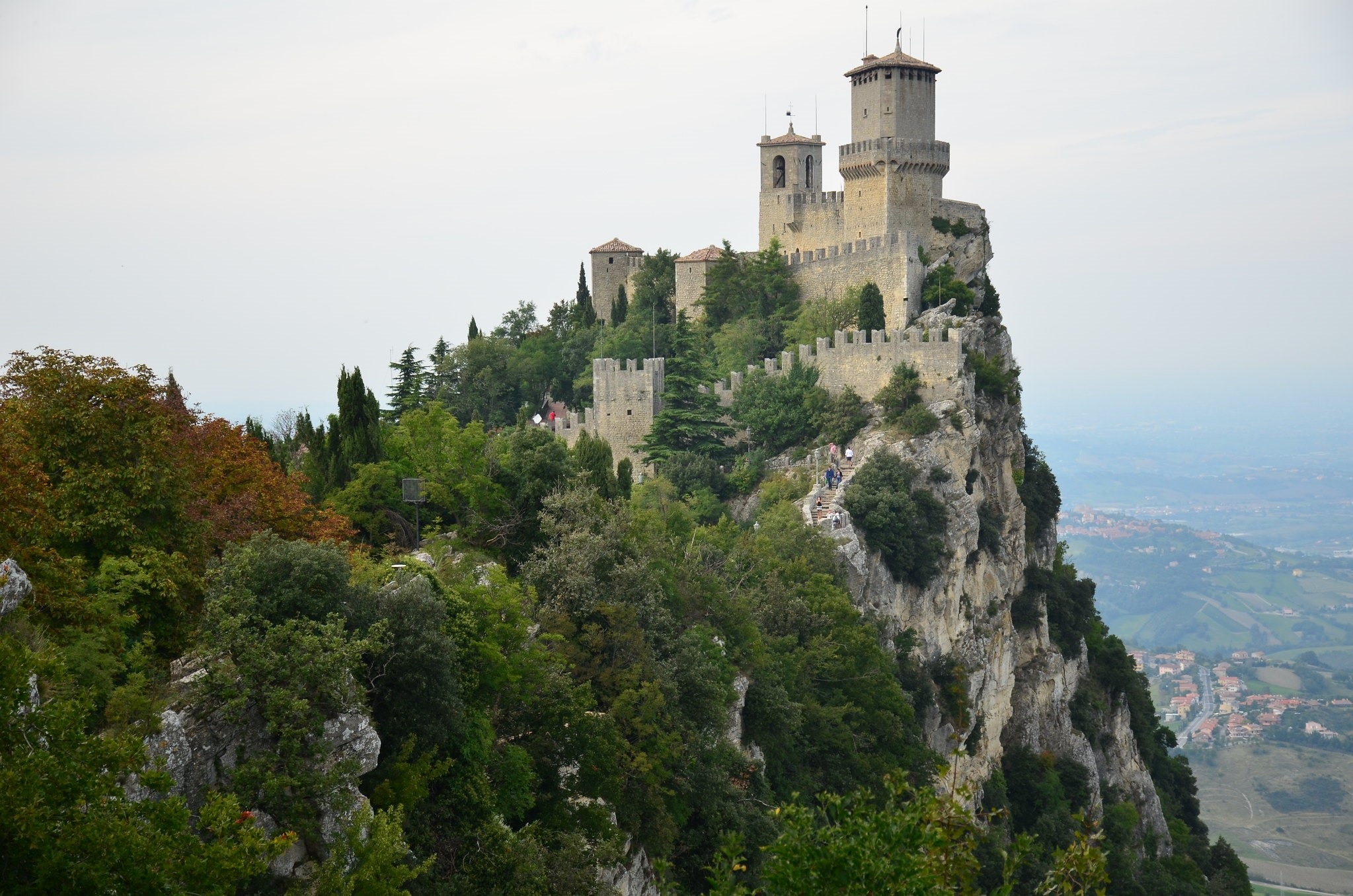
When Napoleon Bonaparte took power in Paris, one of his first statements was to express his admiration for San Marino – a unique example of freedom and democracy in the history of Europe[1]. Something of which the inhabitants of Mount Titano are justifiably proud, but which has not made life any easier for them: San Marino has obvious difficulties, in its search for a road to prosperity, in finding effective tools, creating an uncontrolled financial centre that led the country to bankruptcy. The crisis came about in the 2000s, when an unhealthy relationship between politics and finance forced the state to fight against revenue from tax evasion and money laundering.
A country with an agricultural and tourist vocation (many of its inhabitants worked on the beaches of the Rimini summer boom of the late 1950s), San Marino was cut off from the Italian economic boom and industrialisation, resulting in the forced emigration of many young locals in search of work. Saving Mount Titano is a tradition of over 300 years of forgers, artists of counterfeiting foreign currencies, with which they have helped to support San Marino families since the 1700s[2]. In the world, the Republic of Mount Titano is famous for its democratic government, and for providing shelter to the enemies of any monarchy – such as Garibaldi’s troops fleeing from the tragic defeat of the Roman Republic in 1849. This help was rewarded with generous trade agreements after the birth of the Kingdom of Italy in 1861, which promoted the birth of the first San Marino credit institutions and made the establishment of its own currency unnecessary, having obtained parity with the Italian coinage[3].
With the Convention of 1862, San Marino obtained the right to mint money within the royal borders and public finances improved considerably – but the local population voted against the introduction of personal taxes, so that the only income of the State remained the taxation of the revenues of the financial institutions and (what would become) legendary) postage stamps[4]. This leads to the inability of the institutions to meet the needs of a growing population, jeopardises the consolidation of the public budget and slows down the modernisation process, because the state has no money to invest, except in the realisation of important public works[5].
These works must somehow be paid for. The grandchildren of the counterfeiters want to become bankers, but in the absence of State regulation, this only leads to disaster: the financiers Vito Serafini and Olinto Amati lead many San Marino citizens to misery, who lose their savings in their projects – the Banca Mutua Popolare Sammarinese (between 1892 and 1895) and the failure of the Prestito a Premi (Loan to Premiums) of the Republic of San Marino[6]. The former fought with the Red Shirts and, in 1891, together with Menotti Garibaldi, founded the Society of veterans of the Homeland Battles, which a year later inaugurated the first headquarters of the San Marino Socialist Party and created a bank that was supposed to guarantee pensions to combatants in the wars of the Risorgimento who came from the Rimini area, but instead collapsed due to mismanagement in just three years[7].
Amati was one of the Captains Regent at the beginning of the twentieth century, and with the institution of a public lottery, he achieved the result, in 1915, of bringing electricity and the telephone to the entire Republic of San Marino, and of completing work on the aqueduct that still serves the population of the fortress today – but the company managing the Prestito a Premi failed, dragging Amati’s name through the mud and leading to his suicide in 1919[8]. Those responsible for the disaster will never be convicted: after Amati’s death, the San Marino population chooses to forget and not to investigate – a typical feature of local culture even in the following decades[9].
The financial centre in the post-war period
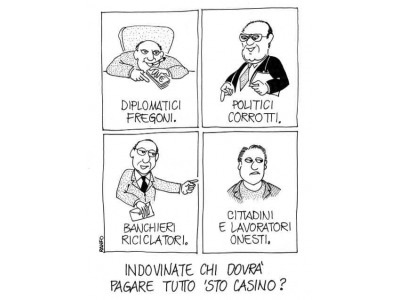
Bitter cartoon by San Marino magazine ‘Libertas’ on the financial collapse of the State and its corruption[10]
Things have not substantially changed in the post-war period. During the years of the Italian economic boom, the San Marino government’s choice, in order to guarantee prosperity without introducing individual taxes, was to encourage the birth of financial entities that would help Italian entrepreneurs, who were poor in foreign languages, to hide their earnings in an offshore financial centre[11] – but also the emerging classes of the newly-born middle class, who hid much less impressive figures, but were a huge number of clients[12].
So the San Marino economy, in the decades that followed, accustomed the population to thinking in billions of lire and, later, in billions of euro. Within a few years, this deeply divided society between winners living in luxury and a class of workers and employees with no hope of redemption, except by entering the banking system. Until, in 2008, at the outbreak of the global financial crisis, and despite numerous international warnings, the utopian dream of wealth was definitively wrecked, and the Republic of San Marino found itself insolvent, forcing its citizens to desperately try to save their savings in foreign banks.
In a country where, in the meantime, there is no longer any difference between corrupt and corrupted, between asset managers and politicians, the only imagined strategy was to sell the national debt to some foreign institution – a measure that would have put an end to centuries of San Marino’s history of independence, and that only after a long political battle was converted into a generalised sale for the issue of perpetual bonds, i.e. with no precise maturity, repayable even in decades, and therefore with a variable interest rate, something that the European Central Bank[13] had never accepted until now, which avoided default but brought San Marino’s debt to staggering and difficult to repay figures in just a few years[14].
The only positive fact: the scare forced the government to enact a serious reform of the financial system, with laws harmonised with European ones[15], and convinced the population to accept the introduction of VAT – the first tax on individuals in centuries of history[16]. This led the local and Italian magistrates to seize increasingly large sums of money from tax evasion, but it also strengthened the international image of San Marino and the hope in the future of its financial centre and in the diminishing corruption of its political and judicial system[17].
The scandal explodes
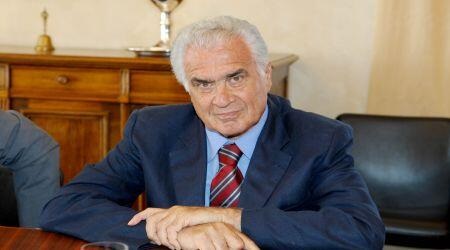
Mario Fantini, president of Delta, arrested in 2009 and died in 2011[18]
The succession of painful criminal investigations by the Italian judiciary, and the Rimini airport disaster (for years a trading port for Russian smuggling[19], and then bankrupted in a momentous corruption scandal[20]), forced the San Marino government to put a stop to carefree finance and, between 2004 and 2008, to order the search of 16 banks, as a result of which criminal investigations were opened into more than 40 suspects, including the owner of the Cassa di Risparmio Sanmarinese and of the Delta Group, a Bologna-based financial group with more than 800 employees, who was arrested on charges of money laundering, fraud, false invoices, embezzlement and abusive banking activities[21].
The Bank of Italy’s inspection of Delta, which ended in February 2009, meant that it could no longer operate as a banking group – a necessary measure given that the illegal activities of Cassa di Risparmio Sanmarinese were directly managed by Delta and its president, Mario Fantini. He used the bank to organise fictitious money transfers in a jurisdiction where, at the time, tax offences did not exist[22]. Between 2004 and 2008, large amounts of money in EUR 500 banknotes were poured into the Titan Bank’s coffers in order to evade Italian tax control.
Together with Fantini, the criminal investigation led to the arrest of the president of the Cassa di Risparmio, Gilberto Ghiotti. An embarrassing arrest, because the Guardia di Finanza had been reporting their suspicions for years, and the Bank of Italy seemed to have its eyes blindfolded. In June 2008, a cash van belonging to the Battistolli company was searched by the Forlì Guardia di Finanza, which recovered 2.6 million euro, ready to cross the Italy-San Marino border without being declared – irrelevant in San Marino, but a serious crime in the European Union. Only in 2007, when the European regulation on the free capital market came into force, did the Bank of Italy and the Ministry of Finance realise the situation[23].
Many Italian entrepreneurs have exploited this system to disguise the transport by lorry of evaded money by falsifying their invoices, showing high costs incurred for work that was never carried out by companies registered in the name of front men who, once the money has been cashed, hand over the cheques to non-existent or complicit persons, who sign them and return them to the sender[24]. These cheques are addressed to the San Marino Savings Bank, and from there to the Central Institute of Popular Banks. At this point, the Cassa di Risparmio requested by fax the withdrawal of cash from Monte dei Paschi di Siena (where a special account had been opened). The Battistolli company had the task of transporting the money from Monte dei Paschi to the Cassa di Risparmio. The money collected was returned (now ‘clean’) to the entrepreneurs, or used to grant loans. Many of the entrepreneurs involved come from Campania, Calabria and Sicily, and are linked to organised crime[25].
The closure of the Cassa di Risparmio creates a domino effect, and brings with it the crisis of the Banca del Titano, which is the final depository of most of the laundered sums. San Marino’s Alleanza Popolare party, born in 1993 on the wave of popular protest against corruption, makes public the most serious facts: in its congressional resolution of 27 March 2006, the State Congress decreed that the State Reserve Bank should guarantee the credit line of about 20 million euro opened by the Central Bank in favour of the Banco del Titano. For Ap members, this is an illegal use of State reserves to finance a private company. Tito Masi, one of the most powerful and corrupt politicians in the Republic[26], swears that savers do not run any risks, but he cannot hide the fact that it will be the citizens of San Marino who will have to pay off the debt of Banca del Titano[27].
The Industrial of Credito Industriale
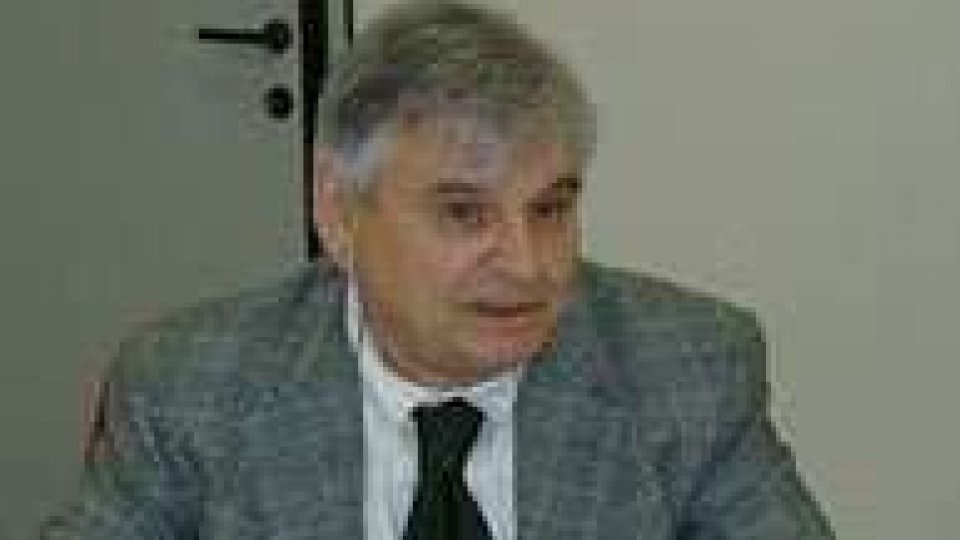
Alvaro Selva, powerful San Marino politician linked to the Italian secret services, also involved in mafia investigations[28]
The more the judiciary digs, the more endless ugly old stories emerge: on 29 June 2018, an important chapter closed, after years, with 17 convictions: we are talking about the Mazzini Account scandal, also known as the ‘San Marino tangentopoli’. The trial brought to light a criminal system led arm in arm by politicians and bankers, which lasted for years and of which the court only managed to prove a fragment – a fraud of more than EUR 1 million. The case takes its name from a certain Giuseppe Mazzini, holder of a current account at the Banca Commerciale di San Marino, into which illicit funds were paid to finance political parties. The latter withdrew the cash from bearer passbooks (the ‘black agendas’, as they were called in the trial), opened by the Finproject financial company in over 20 years of activity, and moreover, subject to espionage by the Italian secret services, which used wiretaps to blackmail politicians and businessmen[29].
The case is so big that it has to be divided into sections, corresponding to the three main companies where the bribes were ‘cleaned up’: Penta Immobiliare, Podeschi-Stolfi and Finproject[30]. At the top of it all is a single awareness: San Marino is in the hands of a criminal group, led by at least 21 people, including eight former Secretaries of State and five former Captains Regent[31]. According to the magistrates, ‘the criminal group has progressively occupied every sector of the economy and colonised every institution’, putting ‘individual opportunism’ before the interests of the country, creating ‘an autonomous structure with respect to the institutional sphere’[32].
A protest movement, RETE, was founded by Roberto Ciavatta, a young postman who, in just a few months, became one of the most influential voices in San Marino. From the pages of the newspapers, he affirmed that “the Mazzini account is only the tip of an iceberg” and said he was convinced that “many of the links between politics and business must still emerge and be punished” and demanded independent enquiries into the activities of the government and the central bank[33].
The top management of Banca CIS (Marino Grandoni, Daniele Guidi and Marco Mularoni) are indicted for fraud, fraud and embezzlement for having used securities owned by customers as collateral for loans obtained from the bank. These illicit financial transactions finally end up in court, where a fabric of decades of intrigues, favours, bribes – all coordinated by Grandoni, who turns out to be the real master of San Marino – is revealed[34]. Once he was brought to court, many of his accomplices admitted the facts: hundreds of millions of euro were used to illicitly finance the historical parties in San Marino[35].
There is a key figure in the shadow of the entire scandal: San Marino lawyer Alvaro Selva, whose political career began in the local Communist Party in 1974 and led him, changing from party to party, until he became a candidate, over 80 years old, on the right-wing list, to hold all the most important posts in the Republic – including that of Minister of the Interior, which brought him into contact with the Italian secret services, for which he was a collaborator[36].
His role is important, and he is investigated by the Mitrokhin Parliamentary Commission, which at the turn of the century investigates the Soviet Union’s espionage and financial meddling in Italian political life – a rollercoaster of dossiers, accusations, bribes, fake police operations, in which Selva almost always appears together with one of the most famous agent provocateurs of the 20th century, Aldo Anghessa[37]. Selva takes money from all sides of the Mazzini Account investigation, but he also collects money from organised crime for his lobbying activities to bring a casino to San Marino[38]. At the end of the whirlwind of slander trials, by now old and politically defeated, Selva was once again investigated for his malicious past – the details of which no one will probably ever know[39].
In foreign hands
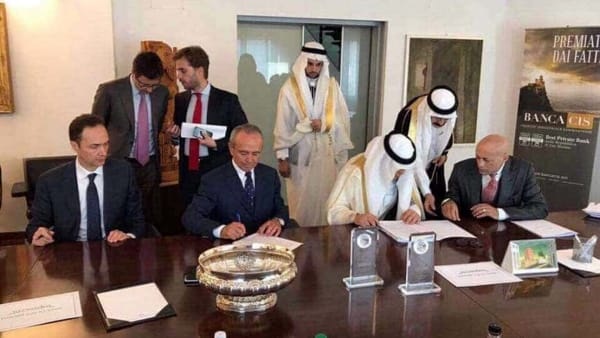
May 2017: a San Marino government delegation signs the sale of banks and national public debt to the United Arab Emirates government[40]
In 2017, San Marino is on its knees: it needs more than half a billion euro for a recapitalisation that, as former Secretary of State Iro Belluzzi said on 19 April in the Great and General Council, cannot be postponed: the country is bankrupt. On top of that, the government has to deal with the shingle of impaired loans, which weigh almost EUR 2 billion on the accounts of local banks. This means that it is impossible to ask for an additional effort from the citizenry, in the form of a tax increase. The solution exists: sell everything to the emirs, who become the real owners of San Marino, and from there create computer technology (including espionage and military) [41] and financial supervision organisations[42].
One of the possible solutions is the sale of one of the most ailing institutions, the Credito Industriale Sammarinese. The bank, which in fact refers to the real estate developer and builder Marino Grandoni (the chain of control starts with the Luxembourg-based Leiton Holding and ends at Banca Partners spa), immediately found possible buyers: the emirs of Qatar and the United Arab Emirates, engaged in a struggle for hegemony in the Persian Gulf[43] and willing to invest any amount of money to gain a foothold in the European financial system[44]: if the Cassa di Risparmio di San Marino were to fall into Arab hands, the local banking system would be at serious risk of being colonised[45].
But it is not only the Arabs who dream of getting their hands on Mount Titano and the beaches of Romagna below: in 2012, on the initiative of the Mayor of Rimini, the airport of Rimini was offered to Russia to avoid bankruptcy[46]. The mayor claims to have realised the potential of Russian tourism, which accounts for 42% of arrivals at Rimini airport. The Russians would realise several projects concerning the airport, the hotel system, the Fair and the Palacongressi. The Fellini airport could thus become an important strategic centre on the Rimini-Moscow-Beijing axis. By increasing flights, Rimini airport could attract tourists from the Middle East[47].
This is not enough. Today, there are over a hundred offshore jurisdictions in the world, and even the most conservative of Italian clients now know how to open a financial company in the Pacific Islands, the Caribbean or the Far East. In order to survive on the global market, it is necessary to guarantee stability, fairness, and transparency, and since 2009, the Republic of San Marino has taken important steps in the direction indicated by the diplomatic agreements (the Monetary Agreement) signed with the European Union[48]. But even this is not enough: San Marino, to compete against the tax havens of exotic countries, must cost less and be more technologically advanced. Things that the small country, dreaming of the glory of Napoleon’s time, finds hard to accept[49].
[1] https://sanmarinofixing.com/2022/02/14/il-legame-tra-san-marino-e-napoleone-bonaparte/
[2] Antonio Carattoni, “Gli scandali finanziari nella storia del piccolo Stato”, AIEP EDITOREM, 2021
[3] Antonio Carattoni, “Gli scandali finanziari nella storia del piccolo Stato”, AIEP EDITOREM, 2021
[4] Antonio Carattoni, “Gli scandali finanziari nella storia del piccolo Stato”, AIEP EDITOREM, 2021
[5] Antonio Carattoni, “Gli scandali finanziari nella storia del piccolo Stato”, AIEP EDITOREM, 2021
[6] Antonio Carattoni, “Gli scandali finanziari nella storia del piccolo Stato”, AIEP EDITOREM, 2021
[7] http://verter.altervista.org/stosocialismo.html
[8] http://dantealighierirsm.org/wp-content/uploads/2017/05/2015-10.pdf, page 181
[9] Repubblica di San Marino, “Relazione della Commissione d’Inchiesta sulla gestione del Prestito a Premi”, San Marino 1919
[10] https://www.libertas.sm/san-marino-come-felici-combattera-l-evasione-fiscale-interna-meglio-ridere-81257/
[11] https://www.wallstreetitalia.com/evasione-fiscale-quel-breve-viaggio-da-rimini-a-san-marino/ ; https://sanmarinofixing.com/2011/06/20/evasione-fiscale-a-san-marino-e-di-dimensioni-gigantesche/
[12] https://www.teleromagna24.it/attualit%C3%A0/rimini-miliardi-di-euro-verso-san-marino-250-indagati-per-evasione-fiscale-video/2016/4
[13] https://espresso.repubblica.it/economia/2021/03/25/news/san_marino_cancella_mezzo_miliardo_di_debiti-293787802/ ; https://www.bsm.sm/source/BSM_ISIN%20SM000A3K7BT5_2032%2007%2021.pdf ; https://www.carisp.sm/wp-content/uploads/2022/02/Aggiornamento-Prezzi-SM000A18X1M6.pdf
[14] https://sanmarinofixing.com/2022/08/04/debito-pubblico-stimato-a-quota-1255-miliardi-di-euro-al-31-12-2022/ ; https://www.libertas.sm/san-marino-la-serenissima-il-debito-pubblico-schizza-a-490-milioni-di-euro/
[15] https://www.hlbsanmarino.com/en/segreto-bancario-non-puo-coprire-levasione-fiscale/ ; file:///C:/Users/Asus/Downloads/17025776Relazionediminor.pdf ; https://www.aiepeditore.com/portfolio-articoli/le-imposte-sui-redditi-nella-repubblica-di-san-marino-maurizio-bastianelli/
[16] https://www.investireoggi.it/fisco/paradisi-fiscali-in-crisi-san-marino-pronta-a-introdurre-liva/
[17] https://giornalesm.com/san-marino-una-riflessione-sul-fallimento-della-piazza-finanziaria-di-luca-lazzari-di-massimo-valentini/?cn-reloaded=1
[18] https://www.altarimini.it/News34808-san-marino-e-morto-mario-fantini-ex-presidente-del-gruppo-delta.php
[19] https://www1.adnkronos.com/Archivio/AdnAgenzia/1999/09/28/Esteri/RUSSIAGATE-NYT-RIMINI-NODO-DEL-RICICLAGGIO-3_145600.php ; https://corrieredibologna.corriere.it/bologna/cronaca/19_ottobre_21/rimini-fermato-contrabbandiere-russo-30mila-sigarette-00de8db8-f40f-11e9-95ca-fd09a54202c0.shtml ; https://www.sanmarinortv.sm/news/attualita-c4/quasi-300-stecche-sigarette-contrabbando-fermato-giovane-russo-aeroporto-fellini-rimini-a79829
[20] https://www.ilfattoquotidiano.it/2013/11/26/aeroporto-di-rimini-il-tribunale-ha-dichiarato-il-fallimento-di-aeradria/791962/ ; https://www.riminitoday.it/cronaca/crac-fallimento-aeradria-sentenza.html ; https://www.italiaoggi.it/archivio/aeroporto-rimini-baraccone-fallito-1853509
[21] https://ricerca.repubblica.it/repubblica/archivio/repubblica/2009/05/05/scandalo-riciclaggio-san-marino-nella-bufera.html ; https://ricerca.repubblica.it/repubblica/archivio/repubblica/2009/05/05/gruppo-delta-cassa-di-marino-per-giudici.html
[22] https://ricerca.repubblica.it/repubblica/archivio/repubblica/2009/05/05/scandalo-riciclaggio-san-marino-nella-bufera.html
[23] https://www.finanzaonline.com/forum/macroeconomia/1059366-cosa-ce-dietro-il-nuovo-scandalo-di-san-marino.html ; https://www.libertas.sm/per-carisp-san-marino-ridicolizzati-funzionari-di-mps-e-bankitalia-13270/
[24] https://www.finanzaonline.com/forum/macroeconomia/1059366-cosa-ce-dietro-il-nuovo-scandalo-di-san-marino.html ; https://www.libertas.sm/per-carisp-san-marino-ridicolizzati-funzionari-di-mps-e-bankitalia-13270/
[25] https://www.repubblica.it/2009/05/sezioni/cronaca/san-marino-riciclaggio/soldi-ripuliti/soldi-ripuliti.html
[26] https://www.libertas.sm/congresso-di-stato-commissione-consiliare-per-gli-affari-di-giustizia-1439/
[27] https://www.sanmarinortv.sm/news/politica-c2/banca-titano-ap-scandalo-regime-a21000
[28] https://www.sanmarinortv.sm/news/politica-c2/commissione-antimafia-alvaro-selva-risponde-a11905
[29] https://www.libertas.sm/san-marino-caso-finproject-spuntano-le-carte-sulle-intercettazioni-l-informazione-di-san-marino-118305/ ; https://www.libertas.sm/antonio-fabbri-linformazione-in-finproject-pure-le-carte-su-chi-doveva-allestire-la-sala-per-le-intercettazioni/
[30] https://contomazzini.home.blog/repubblica-san-marino-conto-mazzini/
[31] https://www.libertas.sm/san-marino-processo-conto-mazzini-la-sentenza-di-secondo-grado-o-appello-condannati-e-assolti/
[32] https://www.libertas.sm/san-marino-marino-cecchetti-solo-per-denaro-lo-stato-piegato-agli-affari-del-gruppo-criminale-104746
[33] https://www.dire.it/07-07-2017/132458-ciavatta-conto-mazzini-solo-punta-un-iceberg-si-celebrino-altri-processi/
[34] https://www.sanmarinortv.sm/news/comunicati-c9/colletti-bianco-azzurri-la-serata-pubblica-di-rete-sui-rinvii-a-giudizio-dei-vertici-di-banca-cis-a221356
[35] https://www.riminiduepuntozero.it/appello-conto-mazzini-processo-sempre-piu-controverso-e-a-rischio-annullamento/
[36] Alvaro Selva on Nexis
[37] https://ibiworld.eu/2020/09/22/in-morte-di-alfa-alfa/
[38] Alvaro Selva on Nexis; https://www.parlamento.it/704?shadow_organo=413114 ; https://espresso.repubblica.it/palazzo/2006/12/07/news/la-repubblica-dei-veleni-1.2146/
[39] Alvaro Selva on Nexis
[40] https://www.today.it/rassegna/san-marino-banche-arabi.html
[41] https://www.sanmarinoqatar.com/
[42] https://bebeez.it/fintech/la-fintech-di-san-marino-bkn301tech-crea-jv-in-qatar-con-sbs-societa-di-consulenza-dello-sceicco-abdulla-eid-m-t-al-thani/ ; https://www.today.it/rassegna/san-marino-banche-arabi.html
[43] GOLFO PERSICO: LA GUERRA DOPO L’ARMISTIZIO | IBI World Italia ; FRATELLO BUONO E FRATELLO CATTIVO: COME LA DINASTIA AL-NAHYAN NASCONDE IL PROPRIO VERO VOLTO | IBI World Italia ; SE ABU DHABI PENSA DI “PILOTARE” DONALD TRUMP | IBI World Italia
[44] EMIRATI: IL GRANDE PARADISO DEI CRIMINALI | IBI World Italia ; QUANDO LA CHAMPIONS LEAGUE LA PERDE ABU DHABI | IBI World Italia
[45] https://www.today.it/rassegna/san-marino-banche-arabi.html
[46] https://www.riminitoday.it/economia/rimini-presenta-l-aeroporto-agli-investitori-russi-e-internazionali.html ; https://www.riminibeach.it/notizie/aeroporto-federico-fellini-accordi-russia ; https://www.libertas.sm/rimini-presentato-laeroporto-fellini-agli-investitori-russi/
[47] Rimini presenta l’aeroporto agli investitori russi e internazionali (riminitoday.it)
[48] file:///C:/Users/Asus/Downloads/Convenzione%20Monetaria%20tra%20Unione%20Europea%20e%20Repubblica%20di%20San%20Marino_entrata%20in%20vigore%20il%2001_09_2012.pdf
[49] https://sanmarinofixing.com/2012/12/14/carlo-pelanda-piazza-finanziaria-futuro-a-portata-di-mano/
Leave a Reply